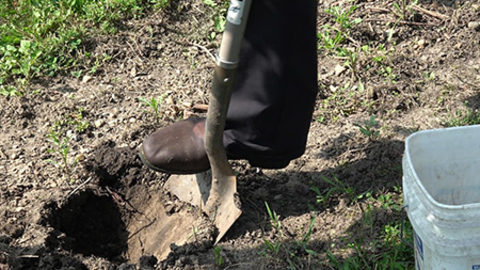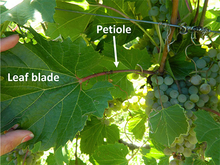Quick facts
- Use tissue testing and soil testing to decide what types and amounts of fertilizer to apply to the vineyard.
- Tissue testing (also called petiole testing) should be done each year, either at bloom or veraison.
- Soil testing should be done before planting the vineyard and every few years after.
- Tissue and soil samples should be sent to the UMN Soil Testing Lab or another diagnostic lab for testing.
- After testing, use established fertilizer recommendations for Minnesota, to decide how to amend or fertilize the soil.
There are 14 essential plant nutrients derived from the soil that are considered essential for the growth of all plants.
These are divided into six macronutrients: nitrogen (N), phosphorus (P), potassium (K), calcium (Ca), magnesium (Mg) and sulfur (S), and eight micronutrients: iron (Fe), manganese (Mn), zinc (Zn), copper (Cu), boron (B), molybdenum (Mo), chlorine (Cl) and nickel (Ni).
If any one of these nutrients is deficient in the vines, it can negatively affect grape yield and quality. When the soil cannot supply enough of each nutrient for adequate growth, you need to apply supplemental fertilizer.
There are two major tools to determine the fertilizer needs of a vineyard: tissue testing and soil testing. The need to supply fertilizer is also based on a number of factors including vine vigor and visual symptoms on the leaves.
Cold climate grapes often need fertilizer to provide the optimal levels and balance of nutrients for plant growth. But fertilizer cannot make up for poor insect and disease control, or correct problems like severe winter injury.
Grapevine tissue testing
Tissue testing (sometimes called tissue analysis or foliar analysis) refers to a set of laboratory tests that measures the concentration of several key nutrients in a grapevine’s leaf tissue.
Tissue testing is based on these facts:
- Optimal concentration ranges exist for each nutrient in plant tissue.
- Maximum fruit yield and quality occur when nutrients are within these ranges.
If the level of a nutrient falls outside of its optimum range, corrective measures should be taken, such as applying fertilizer or raising or lowering the soil pH with lime or sulfur, respectively.
Vineyard soil testing
Soil testing measures the soil pH, organic matter percentage (OM%) and the concentration of key nutrients such as phosphorus, potassium, magnesium, boron and micronutrients.
Conduct a soil test in the year before planting a new vineyard. This allows time to amend the soil and apply fertilizer before planting the vineyard. It is easiest to incorporate fertilizer before planting.
Once the vineyard is planted, it becomes more difficult to alter soil pH and levels of many nutrients because it will not be possible to incorporate fertilizer more than a couple of inches deep without damaging the vine roots.
Soil testing is also recommended every three to five years for established vineyards, to supplement tissue test interpretations.
When to use tissue testing vs. soil testing
Both tissue testing and soil testing serve important purposes in grape production. Soil tests show the nutrient, pH, and organic matter levels in the soil. Tissue tests show the actual nutrient status of the grapevines; in other words, how much of each essential nutrient that the plants take up.
Tissue tests should be conducted at least once per year to check the nutrient status of the grapevines. This can take place at bloom, veraison, or both.
Soil tests, on the other hand, should be used prior to planting to determine the organic matter and pH levels, lime requirements, as well as phosphorus, potassium, magnesium and micronutrient needs of the soil. They should also be conducted any time after significant soil amendments are applied, in order to measure their effect on soil chemical properties. In established vineyards, soil tests are primarily used as a supplement to tissue analysis information and should be done every three to five years.
Tissue testing
Grapevine leaf tissue is collected by the vineyard operator and sent to a laboratory for nutrient testing. The laboratory then creates a report that the vineyard operator can use to determine fertilizer needs.
Many factors affect grapevine nutrient status. Whenever possible, consider these factors when interpreting tissue analysis results.
Certain factors can impact the ability of the grapevines to take up nutrients from the soil. At times, the nutrient content in the plant’s leaves may be low even if the soil nutrient content is high, because the plant is not able to access adequate amounts of nutrients in the soil. There are a number of possible reasons why this may happen.
- Factors that directly affect plant nutrient uptake include:
- soil moisture
- soil texture and structure
- soil pH
- parent material (material from which soil was formed)
- fertilizer practices
- Plant roots take up nutrients through water in the soil. If soil moisture is very low, it can prevent the roots from taking up adequate nutrients.
- Soil pH affects the availability of each nutrient to the plant. If soil pH is outside the optimum range some nutrients may not be available even if they are present in large quantities.
- Factors that indirectly affect plant nutrient uptake include:
- crop load (amount of fruit on the vine)
- vine balance (ratio of vegetative growth and fruit)
- grape variety
- disease and insect damage
- weather conditions
- cultural practices such as weed control and pruning
Petioles are the part of the plant recommended for tissue testing in cold climate grapevines. In most other fruit crops, the entire leaf is used, but research has shown that petiole tissue is best for grapes. When used properly, petiole analysis provides the most reliable method to determine fertilizer needs for established vineyards.
- The sample should contain 75-100 petioles and be representative of the grapevines in the vineyard or sample area. This means sampling from many randomly chosen vines, and not purposefully selecting the worst or best vines in the vineyard for sampling.
- Getting a representative sample is important to avoid misleading results and incorrect interpretations of the results. Even the best-equipped laboratory cannot make up for a poorly collected or mishandled sample.
- Optimum nutrient ranges are based on petioles sampled at a specific maturity level (how old the leaf is) and therefore they should be collected at specific periods during the growing season (bloom or veraison).
Follow these steps to collect your samples
- Collect the sample either at full bloom (mid to late June) or early veraison (mid July to mid August). While nutrient sufficiency levels have been established for both periods, the veraison timing is thought to provide a more accurate assessment of grapevine nutrient status.
- At least 25 to 50 vines should be selected for sample collection to get 75-100 petioles. Vines that are not typical of the vineyard, such as vines that are overly vigorous or on the edge of a row, should be avoided.
- Vines should be of the same age, variety and rootstock, growing on a relatively uniform soil of the same fertility. If these conditions are not met, divide the vineyard into uniform blocks and sample separately for each block.
- If trying to diagnose a problem, take a sample from vines exhibiting the problem and a separate sample made up of healthy vines for comparison. This can be done at any time of the growing season.
- For sampling at full bloom, take the petioles from leaves directly opposite the bottom flower cluster. For samples collected at veraison, take petioles from the most recently developed mature leaves.
- Collect a total of 75 to 100 petioles (more may be required from cultivars with short petioles) from 25-50 vines (two or three petioles per vine). More may be required from varieties with small petioles. Do not pick more than one leaf from anyone cane. Discard the leaf blade and keep the petiole. Leaves showing insect, disease, or mechanical damage should not be selected for sampling.
- If petioles are dusty or dirty, rinse them in distilled or deionized water. Do not let petioles soak in water because nutrients will leach out.
- Place petioles in a clean paper bag and dry at room temperature or send immediately to a laboratory. Do not use plastic bags unless samples have been previously dried.
The University of Minnesota Research Analytical Laboratory offers tissue testing services for a fee. For information and current pricing, go to the UMN Soil Testing Laboratory website and select the Diagnostic Plant Sheet form from the home page.
A number of other laboratories also offer tissue testing services. For a list of other laboratories located in the upper Midwest, visit the Minnesota Department of Agriculture website.
Nutrient sufficiency levels in grape petioles
| Nutrient | Full bloom | Early veraison |
|---|---|---|
| Mid to late June | Mid July to mid August | |
| Nitrogen (%) | 1.20 - 1.80 | 0.80 - 1.20 |
| Phosphorus (%) | 0.20 - 0.65 | 0.15 - 0.60 |
| Potassium (%) | 1.40 - 3.10 | 1.40 - 3.20 |
| Calcium (%) | 0.40 - 1.50 | 1.20 - 1.80 |
| Magnesium (%) | 0.20 - 0.50 | 0.26 - 0.80 |
| Sulfur (%) | 0.10 - 0.25 | 0.10 - 0.25 |
| Manganese (ppm) | 20 - 150 | 25 - 150 |
| Boron (ppm) | 25 - 50 | 25 - 50 |
| Copper (ppm) | 7 -12 | 5 - 9 |
| Zinc (ppm) | 20 - 100 | 25 - 50 |
| Iron (ppm) | 30 - 180 | 25 - 100 |
| Molybdenum (ppm) | 0.2 - 0.4 | 0.3 - 1.5 |
If pesticides containing copper, zinc or manganese were sprayed on the vines, then concentrations of these elements may be much higher in the tissue. This is usually not a cause for concern, because most of the sprayed elements are on the tissue surface.
Soil testing
Follow these steps for taking soil samples
- For new vineyards, collect soil samples the year before the vineyard will be planted. While samples can be collected any time of the year, spring and early fall are usually the most convenient. Waiting until mid-late fall in Minnesota may mean there is not enough time to amend the soil before snow cover.
- For fields not yet planted, samples should be from uniform areas. Each sample area should have the same soil texture and color, cropping history, and fertilizer, manure and lime treatments. Fields with varying topography may require multiple samples.
- One sample should not represent more than 20 acres on uniform land and five acres on rolling land.
- Each soil sample should contain soil from at least 10-15 subsamples taken at randomly selected locations throughout the sample area.
- While soil test interpretations and recommendations are based primarily on soil from the top 0-8 inches, growers should collect samples from 0-8 inches and 8-16 inches before planting.
- In established vineyards, sample from 0-8 inches deep from within the vine rows rather than between the rows. It is best to take separate samples for each variety if possible.
- Collect the samples with a soil sampling tube, soil auger or garden spade.
- 10-15 subsamples (one core or shovel per subsample) should be collected from randomly selected areas within the field or rows.
- After collecting the subsamples, mix them together thoroughly in a plastic pail, and place about 1 pint of the mixed soil in a sample bag or box. Use a generic paper bag, or pick up a UMN Soil Testing Laboratory bag from your county Extension office. Submit this sample to the testing laboratory with payment and the submission form.
Refer to the U of M soil testing website for the field information sheet and instructions. For a list of other laboratories located in the upper Midwest, visit the Minnesota Department of Agriculture website.
Upon receiving the soil test report, use University of Minnesota soil test recommendations to interpret the numbers and determine levels of fertilizer to apply.
The Nutrient Management Guide for Fruit and Vegetable Crops shows how to interpret the nutrient concentrations, pH, and organic matter on the report. The tables below may also be used, but refer to the guide for more information on soil test interpretation.
Low, medium and high levels of soil nutrients, organic matter and pH for grapevines in Minnesota, based on soil test results
| Test Result | Low | Medium | High | Very High |
|---|---|---|---|---|
| Organic matter (OM%) | <3.1% | 3.1-4.5% | 4.6-19% | >19% (peat or muck) |
| pH (6 to 7 is optimal) | <7.0 | 7 | >7.0 | - |
| Phosphorus (ppm, Bray P1 on soils with pH 7.4 or less) | 0-5 | 6-10 | 16-25 | >25 |
| Phosphorus (ppm, Bray P1 on soils with pH >7.4) | 0-3 | 4-7 | 12-18 | >18 |
| Potassium (ppm) | 0-50 | 51-100 | 101-150 | >150 |
| Magnesium (ppm) | 0-50 | 51-100 | >100 | - |
| Calcium (ppm) | 0-300 | 301-600 | >600 | - |
| Boron (ppm) | 0-0.5 | 0.6-1.0 | >1.0 | - |
| Zinc (ppm) | 0.0.5 | 0.6-1.0 | >1.0 | - |
| Manganese (ppm) | 0-1 | 1.1-5.0 | >6.0 | - |
| Copper (ppm) | 0-0.1 | 0.1-0.2 | >0.2 | - |
First, compare the nutrient concentrations on your test report to the nutrient tables in the Nutrient Management Guide for Fruit and Vegetable Crops, to determine how many pounds per acre of each nutrient is needed.
Potassium recommendations for established planting fruit crops
| Crop | Approx. yield goal | Soil test K level: 0-40 ppm | Soil test K level: 41-80 ppm | Soil test K level: 81-120 ppm | Soil test K level: 121-160 ppm | Soil test K level: 161-200 ppm | Soil test K level: 201+ ppm |
|---|---|---|---|---|---|---|---|
| Apples | 140 (cwt/acre) | 200 (lb/acre K2O to apply) | 150 (lb/acre K2O to apply) | 100 (lb/acre K2O to apply) | 50 (lb/acre K2O to apply) | 0 (lb/acre K2O to apply) | 0 (lb/acre K2O to apply) |
| Blueberries | 50 | 150 | 100 | 50 | 25 | 0 | 0 |
| Grapes | 60 | 200 | 150 | 100 | 50 | 0 | 0 |
| Raspberries | 40 | 100 | 75 | 50 | 25 | 0 | 0 |
| Strawberries | 100 | 200 | 150 | 100 | 50 | 0 | 0 |
According to the chart, decide which fertilizer product to apply, and calculate the rate required to meet the nutrient needs. Each fertilizer product has a specific concentration of each nutrient it contains.
Use the guide recommendations and nutrient concentrations on the product label to calculate the rate of fertilizer to apply to the vineyard. Details on these calculations are included in Calculating Fertilizer Rates for Vegetable and Fruit Crops and the nutrient management guide linked above.
Fertilizer should be applied to the grapevine rows rather than the grassy areas between the rows.
Apply soil fertilizer in the spring or fall. Do not apply nitrogen to cold climate grapevines after July. Doing so may cause unnecessary late-season leaf growth and reduce the vines’ ability to harden off for the winter.
Reviewed in 2021





